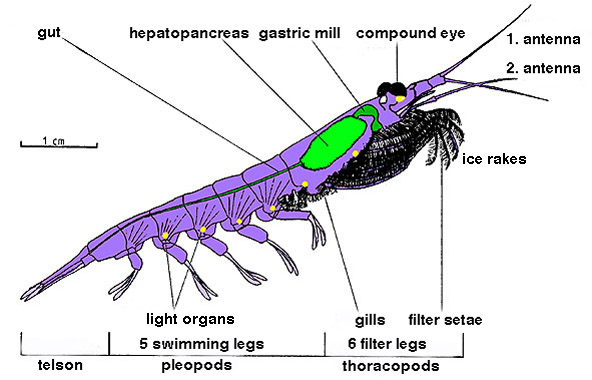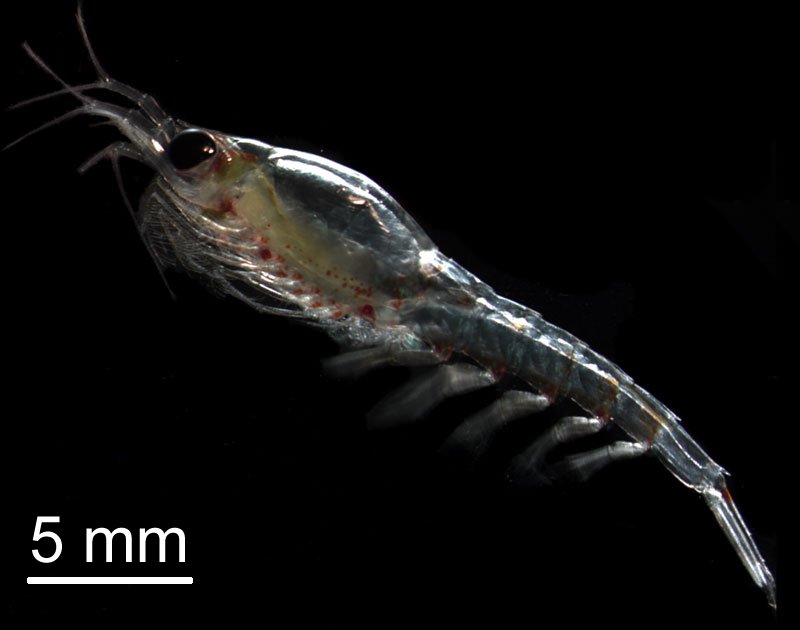|
Krill
Krill ''(Euphausiids)'' (: krill) are small and exclusively marine crustaceans of the order (biology), order Euphausiacea, found in all of the world's oceans. The name "krill" comes from the Norwegian language, Norwegian word ', meaning "small Fry (biology), fry of fish", which is also often attributed to species of fish. Krill are considered an important trophic level connection near the bottom of the food chain. They feed on phytoplankton and, to a lesser extent, zooplankton, and are also the main source of food for many larger animals. In the Southern Ocean, one species, the Antarctic krill, makes up an estimated biomass (ecology), biomass of around 379 million tonnes, making it among the species with the largest total biomass. Over half of this biomass is eaten by whales, Pinniped, seals, penguins, seabirds, squid, and fish each year. Most krill species display large diel vertical migration, daily vertical migrations, providing food for predators near the surface at night an ... [...More Info...] [...Related Items...] OR: [Wikipedia] [Google] [Baidu] |
Antarctic Krill
Antarctic krill (''Euphausia superba'') is a species of krill found in the Antarctica, Antarctic waters of the Southern Ocean. It is a small, swimming crustacean that lives in large schools, called swarms, sometimes reaching densities of 10,000–30,000 animals per cubic metre. It feeds directly on minute phytoplankton, thereby using the primary production energy that phytoplankton originally derive from the sun in order to sustain its pelagic biological life cycle, life cycle. It grows to a length of , weighs up to , and can live for up to six years. A key species in the Antarctic ecosystem and in terms of biomass (ecology), biomass, ''E. superba'' is one of the most abundant animal species on the planet, with a cumulative biomass of approximately . Life cycle The main spawn (biology), spawning season of Antarctic krill is from January to March, both above the continental shelf and also in the upper region of deep sea oceanic areas. In the typical way of all krill, the male at ... [...More Info...] [...Related Items...] OR: [Wikipedia] [Google] [Baidu] |
Meganyctiphanes
Northern krill (''Meganyctiphanes norvegica'') is a species of krill that lives in the North Atlantic Ocean including the Norwegian Sea, North Sea, and parts of the Mediterranean. It is an important component of the zooplankton, providing food for whales, seals, fish, and birds. In the Southern Ocean, Antarctic krill '' Euphausia superba'' fills a similar role. ''M. norvegica'' is the only species recognized in the genus ''Meganyctiphanes''. Northern krill supply a crucial link in the North Atlantic Ocean food web, transmitting energy from primary producers to high-level predators. Krill in the North Atlantic Oceans feed on phytoplankton, copepods, and other zooplankton. Anatomy and morphology External morphology Similar to all krill species, northern krill are crustaceans that possess a transparent chitinous exoskeleton. Northern krill can grow up to 4-6 centimeters long in adult hood, although on average they are 1.5–2 centimeters. Their anatomy is a decapod consisting ... [...More Info...] [...Related Items...] OR: [Wikipedia] [Google] [Baidu] |
Southern Ocean
The Southern Ocean, also known as the Antarctic Ocean, comprises the southernmost waters of the world ocean, generally taken to be south of 60th parallel south, 60° S latitude and encircling Antarctica. With a size of , it is the second-smallest of the five principal oceanic divisions, smaller than the Pacific Ocean, Pacific, Atlantic Ocean, Atlantic and Indian Ocean, Indian oceans, and larger than the Arctic Ocean. The maximum depth of the Southern Ocean, using the definition that it lies south of 60th parallel, was surveyed by the Five Deeps Expedition in early February 2019. The expedition's multibeam sonar team identified the deepest point at 60° 28' 46"S, 025° 32' 32"W, with a depth of . The expedition leader and chief submersible pilot Victor Vescovo, has proposed naming this deepest point the "Factorian Deep", based on the name of the crewed submersible ''DSV Limiting Factor'', in which he successfully visited the bottom for the first time on February 3, 2019 ... [...More Info...] [...Related Items...] OR: [Wikipedia] [Google] [Baidu] |
Thysanoessa
Thysanoessa is a genus of the krill that play critical roles in the marine food web. They're abundant in Arctic and Antarctic areas, feeding on zooplankton and detritus to obtain energy. Thysanoessa are responsible for the transportation of carbon and nutrients from surface waters to deeper trophic levels. This genus serves as prey for various fish and provide energy to marine ecosystems as they are at a low trophic level. Most travel through vertical migration, meaning they travel up and down in the water column, providing food for predators at the surface during the night, and at deeper levels during the day. Growth & development Longevity in this genus varies depending on the specie. The average lifespan for the Thysanoessa is between three and four years. The development and growth of this organism takes place during winter to autumn. Thysanoessa are broadcast spawners, meaning that the males will physically put their sperm onto the female's body so that the eggs become ferti ... [...More Info...] [...Related Items...] OR: [Wikipedia] [Google] [Baidu] |
Euphausia
''Euphausia'' is the largest genus of krill, and is placed in the family Euphausiidae. There are 31 species known in this genus, including Antarctic krill (''Euphausia superba'') and ice krill ('' Euphausia crystallorophias'') from the Southern Ocean, and North Pacific krill ('' Euphausia pacifica'') in the Pacific Ocean The Pacific Ocean is the largest and deepest of Earth's five Borders of the oceans, oceanic divisions. It extends from the Arctic Ocean in the north to the Southern Ocean, or, depending on the definition, to Antarctica in the south, and is .... Species *'' Euphausia americana'' Hansen, 1911 *'' Euphausia brevis'' Hansen, 1905 *'' Euphausia crystallorophias'' Holt & Tattersall, 1906 *'' Euphausia diomedeae'' Ortmann, 1894 *'' Euphausia distinguenda'' Hansen, 1908 *'' Euphausia eximia'' Hansen, 1911 *'' Euphausia fallax'' Hansen, 1916 *'' Euphausia frigida'' Hansen, 1911 *'' Euphausia gibba'' G. O. Sars, 1883 *'' Euphausia gibboides'' Ortmann, 1893 *'' E ... [...More Info...] [...Related Items...] OR: [Wikipedia] [Google] [Baidu] |
Crustacean
Crustaceans (from Latin meaning: "those with shells" or "crusted ones") are invertebrate animals that constitute one group of arthropods that are traditionally a part of the subphylum Crustacea (), a large, diverse group of mainly aquatic arthropods including decapods (shrimps, prawns, crabs, lobsters and crayfish), seed shrimp, branchiopods, fish lice, krill, remipedes, isopods, barnacles, copepods, opossum shrimps, amphipods and mantis shrimp. The crustacean group can be treated as a subphylum under the clade Mandibulata. It is now well accepted that the hexapods (insects and entognathans) emerged deep in the Crustacean group, with the completed pan-group referred to as Pancrustacea. The three classes Cephalocarida, Branchiopoda and Remipedia are more closely related to the hexapods than they are to any of the other crustaceans ( oligostracans and multicrustaceans). The 67,000 described species range in size from '' Stygotantulus stocki'' at , to the Japanese ... [...More Info...] [...Related Items...] OR: [Wikipedia] [Google] [Baidu] |
Bentheuphausia
''Bentheuphausia amblyops'', the deep sea krill is a species of krill. ''B. amblyops'' is the only species within its genus, which in turn is the only genus within the family Bentheuphausiidae. All the 85 other species of krill known are classified in the family Euphausiidae. Distribution ''B. amblyops'' occurs in the northern Atlantic Ocean in latitudes south of 40° N, and also in the southern seas of the Atlantic, in the Indian Ocean and in the Pacific. It is a bathypelagic krill that lives in deep waters below . Description It is distinguished from the Euphausiidae by several morphological features, the most apparent being that they are not bioluminescent and that their first pair of pleopod The anatomy of a decapod consists of 20 body segments grouped into two main body parts: the cephalothorax and the pleon (abdomen). Each segment – often called a somite – may possess one pair of appendages, although in various groups these m ...s is not modified as copulato ... [...More Info...] [...Related Items...] OR: [Wikipedia] [Google] [Baidu] |
Biomass (ecology)
Biomass is the mass of living biological organisms in a given area or ecosystem at a given time. Biomass can refer to ''species biomass'', which is the mass of one or more species, or to ''community biomass'', which is the mass of all species in the community. It can include microorganisms, plants or animals. The mass can be expressed as the average mass per unit area, or as the total mass in the community. How biomass is measured depends on why it is being measured. Sometimes, the biomass is regarded as the natural mass of organisms ''in situ'', just as they are. For example, in a salmon fishery, the salmon biomass might be regarded as the total wet weight the salmon would have if they were taken out of the water. In other contexts, biomass can be measured in terms of the dried organic mass, so perhaps only 30% of the actual weight might count, the rest being water. For other purposes, only biological tissues count, and teeth, bones and shells are excluded. In some application ... [...More Info...] [...Related Items...] OR: [Wikipedia] [Google] [Baidu] |
Nyctiphanes
''Nyctiphanes'' is a genus of krill, comprising four species with an anti-tropical distribution. Based on molecular phylogenetic analyses of the cytochrome oxidase gene and 16S ribosomal DNA, ''Nyctiphanes'' is believed to have evolved during the Miocene The Miocene ( ) is the first epoch (geology), geological epoch of the Neogene Period and extends from about (Ma). The Miocene was named by Scottish geologist Charles Lyell; the name comes from the Greek words (', "less") and (', "new") and mea .... References Krill Crustacean genera Taxa named by Georg Ossian Sars {{Malacostraca-stub ... [...More Info...] [...Related Items...] OR: [Wikipedia] [Google] [Baidu] |
Hansarsia
''Hansarsia'' is a genus of krill Krill ''(Euphausiids)'' (: krill) are small and exclusively marine crustaceans of the order (biology), order Euphausiacea, found in all of the world's oceans. The name "krill" comes from the Norwegian language, Norwegian word ', meaning "small ..., formerly known by the name ''Nematoscelis'' (e.g.), a junior homonym. Species References Krill Crustacean genera {{Malacostraca-stub ... [...More Info...] [...Related Items...] OR: [Wikipedia] [Google] [Baidu] |
Thysanopoda
''Thysanopoda'' is a genus of krill Krill ''(Euphausiids)'' (: krill) are small and exclusively marine crustaceans of the order (biology), order Euphausiacea, found in all of the world's oceans. The name "krill" comes from the Norwegian language, Norwegian word ', meaning "small ..., containing the following species: *'' Thysanopoda acutifrons'' Holt & Tattersall, 1905 *'' Thysanopoda aequalis'' Hansen, 1905 *'' Thysanopoda astylata'' Brinton, 1975 *'' Thysanopoda cornuta'' Illig, 1905 *'' Thysanopoda cristata'' G. O. Sars, 1883 *'' Thysanopoda egregia'' Hansen, 1905 *'' Thysanopoda microphthalma'' G. O. Sars, 1885 *'' Thysanopoda minyops'' Brinton, 1987 *'' Thysanopoda monacantha'' Ortmann, 1893 *'' Thysanopoda obtusifrons'' G. O. Sars, 1883 *'' Thysanopoda orientalis'' Hansen, 1910 *'' Thysanopoda pectinata'' Ortmann, 1893 *'' Thysanopoda spinicaudata'' Brinton, 1953 *'' Thysanopoda tricuspidata'' Milne-Edwards, 1837 References External links * Krill Crustacean gene ... [...More Info...] [...Related Items...] OR: [Wikipedia] [Google] [Baidu] |




